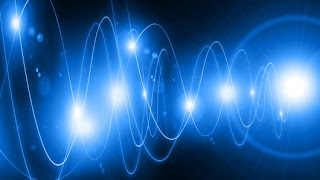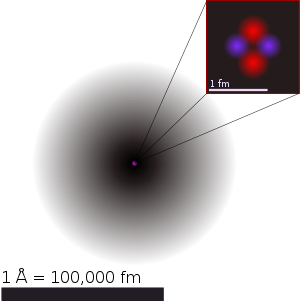 |
| Not all space-time is the same |
This causes a bit of a problem though. In a previous post I mentioned Newton's second law. This law basically says that to accelerate something you have to be giving it a shove. So the question then arises as to what is actually giving the universe a shove? If it is accelerating then some force must be in play.
I have no problem with an accelerating expanding universe. I quite like the idea because it gives us something to think about. It's not supposed to be that way, so we must have something wrong. It is just a question of what?
We measure the speed that galaxies are receding using a technique called red-shift This can be explained as the Doppler effect on light. All atoms emit light radiation at very particular frequencies when an electron drops from an excited state to a lower state. This amazing property that I shall cover elsewhere allows us to determine some of the elements in stars.
If a star is moving away from us then it was discovered that the frequency of the emitted light tended to be shifted slightly towards the red end of the spectrum. Taking this a step further it was realised that the amount of this shift was dependent on the speed that a star or galaxy was receding from us. The faster the stars or galaxies are receding the greater the red shift.
This is not all though, oh no my friend, see there is more, we know the universe is expanding, Hubble proved this back in the day, and it was soon realised that there may be an additional red shift due to the fact that gravity can cause red-shift in light. An explanation for this can be found in General Relativity and experiments show that it real. Basically the higher the gravitation field the greater the red shift in the light escaping.
I could be wrong about this but it seems to me that we assume that space-time is the same in flat space. Flat space are those regions were there are few stars, the space between galaxies. There is an awful lot of this by the way. Seriously, there is a lot of the universe that just appears to have practically nothing in it. You want to find something close to the perfect vacuum... deep space. We are looking at 1 atom in a cubic meter of space, compare this with the best vacuum ever achieved on Earth. The best we vacuum we have achieved on Earth has about 100 million atoms per meter cubed. That is a fantastic vacuum by the way.
There is virtually nothing in deep space, I am serious, talk about the void, this is it mate and the amount of it is beyond the imagination of everyone. You might think you have a great imagination, but it is nowhere near capable of imagining the vastness of deep space.
Another thing is that we are working on the basis that our interpretation of the current observations of red-shift are correct, in other words the current theories are right.
OK so lets tackle these in reverse order.
The theories are correct. Well here is the thing, almost all of them are bound to be wrong. There are so many things we simply can't explain already, small galaxies that appear to have super massive black holes, 4 billion solar masses no less, galaxies that don't appear to behave Newton's laws of gravity even though they should! This madness actually gives rise to the idea of dark matter and dark energy. So are the correct... no, so if they are incorrect then chances are they may have a fault or two when it comes to red-shift.
Yes this is a bit of a cop out, but I genuinely think that the way we are measuring red-shift may be an issue, which brings me to point one.
Now to the ignorant, namely me, sea is just sea, it's water, salty water. This is not the case though. There is a very clear point where the Pacific meets the Atlantic and the salt concentration in the water is different between the two seas. Not only that, but where the world meets Antarctica there is a detectable sharp drop in the temperature of the water. This was a bit of a revelation to me because I'd wrongly assumed that sea water was pretty much the same. Not so and this got me pondering.
It occurred to me that something similar could happen in space. Image regions that have a greater concentration of energy than another region, much in the same way that galaxies contain a far greater concentration of mass than deep space, where there is practically none. Now I would have thought that given enough time, the balance of salt between the pacific and Atlantic oceans would balance out, but no. Something (the Amazon basin probably) is reducing the concentration of salt so it never matches up to the pacific ocean.
Again, imagine if something like this is occurring in space. So one region is continually being topped up, or depleted compared with another.
Now if something like this did take place then the regions of space-time may actually be different and their properties with regard to the way light propagates may be different. My thinking then is that the results we see may be erroneous because we are assuming the space time is linear and constant in the regions of deep space, when actually it may not be. Imagine if there are similar sharp changes between space-time depending on where you are in the universe?
So to try and some this one up, what I may be saying (bit of sitting on the fence here) is that the idea of the universes expanding faster than it should could actually be wrong. The observations are clear, but our interpretation of them may be skewed because space time is not flat in the way we think even in deep space. You can have two flat regions with a clear gradient between them. This gradient, or the different nature of the regions of space-time causes some of the light shift itself, thus distorting the results.
I am just having a play with the Doppler equations for red-shift, if I find anything interesting I'll post it later.





 is the wavelength
is the wavelength is the Planck's constant
is the Planck's constant is the momentum
is the momentum is the
is the  is the
is the  is the
is the 



















